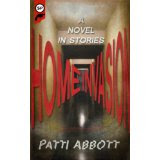The Iron Gates was Margaret Millar’s fifth novel, published in 1945. It introduced Inspector Sands of the Toronto police force. Millar (who was, of course, Ross Macdonald’s wife) didn’t use Sands in her novels often, and The Iron Gates was not one of her more famous crime novels. The Edgar Award-winning Beast in View (1955), How Like an Angel (1962), and The Fiend (1964) are the three books for which she’s probably best known. Although Millar is not well-remembered nowadays, devotees find her writing particularly rewarding. She’s especially skillful at portraying women, although her stories are very different from those of writers known for targeting female audiences.
Millar’s greatest strength was in exposing the psychological underpinnings of a crime. Her books are more about motivation than detection. What appealed to me most as I read her novels back in the 1970s was that her writing was never formulaic or predictable. Her best work is found in the standalones. Even Sands, a charming and fully fleshed-out detective, never steals the story from the women who dominate The Iron Gates entirely. It’s not about the detective.
Lucille Morrow lives with her wealthy physician husband, his two grown children, and his sister, Edith, in a large house in Toronto, Ontario. Lucille is Andrew’s second wife. His first wife, Mildred, was murdered in a nearby park 16 years earlier. That case was never solved. The two stepchildren, Polly and Andrew, tolerate their stepmother. And she tolerates them. This uneasy rapprochement begins to come undone when Polly, along with her father and brother, goes to pick up her new fiancé, a soldier who’s coming to Toronto to meet the family. A train crash complicates their trip, but they return home later that night.
The next day, Lucille suddenly disappears after a visit from a strange man carrying a small wrapped box. The last that is heard from her is a scream. She is eventually run down by the Toronto police and her condition is such that she’s institutionalized. This action, mainly occurring in the Morrow household, forms the first section of the novel, which Millar labels as “The Hunt.”
The middle section, “The Fox,” details Lucille’s state of mind as she hides from an assailant, the police, or perhaps her own fears in a mental hospital. The reader is unsure which she sees as the greatest threat. Her involvement with other patients turns out badly. Much of this section of the novel describes her mental anguish, and the reader is left to ponder whether Lucille is the victim she appears to be. Who or what is after her?
The final section of this novel, “The Hounds,” details Sands’ solution to the crimes that have taken place. This section is again largely set in the Morrow household and concerns a diary newly unearthed. Giving away any more plot points would ruin the delicate nature of Millar’s story.
It’s hard to imagine this book being written today, because of its lengthy depiction of a mentally fragile woman in an institution. Today, Lucille Morrow would be prescribed an appropriate drug. Or perhaps she’d be under the daily care of a psychiatric nurse at home. Nevertheless, Millar uses the middle section of The Iron Gates to provide clues, and to do what she does best: show the unraveling of a psyche. It’s also the section of this book that makes Millar’s storytelling different. We go from the calm, if slightly hothouse, feel of the Morrow home in section one, to the agitated madhouse of section two, and then back again.
This novel was apparently purchased after World War II as a vehicle for actress Bette Davis, but was never filmed. I think she would have done justice to Lucille Morrow. However, after reading The Iron Gates, you will understand why the movie wasn’t made.

















8 comments:
Even lesser Margaret Millar remains head and shoulder above the crowd. I have always likens her to Helen McCloy and Charlotte Armstrong, two other women writers who were not averse to try something new.
I like Millar very much, Patti. This may not be her top work, but it appeals to me. As Jerry said, even her weakest is better than a lot of people's best!
I agree with Jerry: even second tier Margaret Millar is better than many writers' best work.
I've only read a few of her books - not sure why - but have enjoyed all of them. I did read her short stories, of course, which are definitely worth looking for.
THE COUPLE NEXT DOOR: COLLECTED SHORT MYSTERIES was published by Crippen & Landru.
I remember THE LISTENING WALLS, HOW LIKE AN ANGEL, A STRANGER IN MY GRAVE.
On the I've Been Meaning To Read list for some years...thanks for a solid review!
I have read several of her novels and liked them but have not read this one although I own a copy.
I don't even have my copy. Or any of her books now. No room.
Patti, this is a wonderful review of this book. The first book I read by Millar was Wall of Eyes, the first Inspector Sands book. Several years later I read The Iron Gates. I liked Inspector Sands a lot in both books, but you are right it wasn't about him, but about the other characters. Millar does write very different mysteries.
Post a Comment